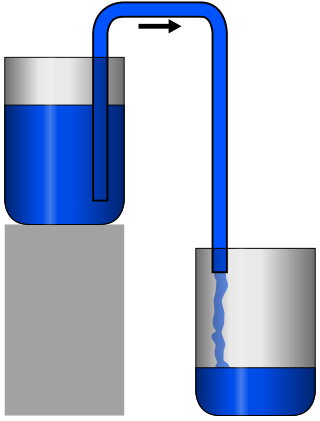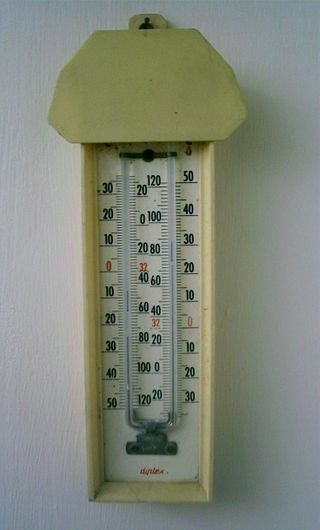
Pressure measurement is the measurement of an applied force by a fluid on a surface. Pressure is typically measured in units of force per unit of surface area. Many techniques have been developed for the measurement of pressure and vacuum. Instruments used to measure and display pressure mechanically are called pressure gauges,vacuum gauges or compound gauges. The widely used Bourdon gauge is a mechanical device, which both measures and indicates and is probably the best known type of gauge.

A thermometer is a device that measures temperature or a temperature gradient. A thermometer has two important elements: (1) a temperature sensor in which some change occurs with a change in temperature; and (2) some means of converting this change into a numerical value. Thermometers are widely used in technology and industry to monitor processes, in meteorology, in medicine, and in scientific research.

A barometer is a scientific instrument that is used to measure air pressure in a certain environment. Pressure tendency can forecast short term changes in the weather. Many measurements of air pressure are used within surface weather analysis to help find surface troughs, pressure systems and frontal boundaries.
Timeline of temperature and pressure measurement technology. A history of temperature measurement and pressure measurement technology.

The mercury-in-glass or mercury thermometer was invented by physicist Daniel Gabriel Fahrenheit in Amsterdam (1714). It consists of a bulb containing mercury attached to a glass tube of narrow diameter; the volume of mercury in the tube is much less than the volume in the bulb. The volume of mercury changes slightly with temperature; the small change in volume drives the narrow mercury column a relatively long way up the tube. The space above the mercury may be filled with nitrogen gas or it may be at less than atmospheric pressure, a partial vacuum.

A hygrometer is an instrument which measures the humidity of air or some other gas: that is, how much water vapor it contains. Humidity measurement instruments usually rely on measurements of some other quantities such as temperature, pressure, mass, a mechanical or electrical change in a substance as moisture is absorbed. By calibration and calculation, these measured quantities can lead to a measurement of humidity. Modern electronic devices use the temperature of condensation, or they sense changes in electrical capacitance or resistance to measure humidity differences. A crude hygrometer was invented by Leonardo da Vinci in 1480. Major leaps came forward during the 1600s; Francesco Folli invented a more practical version of the device, while Robert Hooke improved a number of meteorological devices including the hygrometer. A more modern version was created by Swiss polymath Johann Heinrich Lambert in 1755. Later, in the year 1783, Swiss physicist and Geologist Horace Bénédict de Saussure invented the first hygrometer using human hair to measure humidity.

In the oil and gas industry, the term wireline usually refers to the use of multi-conductor, single conductor or slickline cable, or "wireline", as a conveyance for the acquisition of subsurface petrophysical and geophysical data and the delivery of well construction services such as pipe recovery, perforating, plug setting and well cleaning and fishing. The subsurface geophysical and petrophysical information results in the description and analysis of subsurface geology, reservoir properties and production characteristics.

A siphon is any of a wide variety of devices that involve the flow of liquids through tubes. In a narrower sense, the word refers particularly to a tube in an inverted "U" shape, which causes a liquid to flow upward, above the surface of a reservoir, with no pump, but powered by the fall of the liquid as it flows down the tube under the pull of gravity, then discharging at a level lower than the surface of the reservoir from which it came.

A gas-filled tube, also commonly known as a discharge tube or formerly as a Plücker tube, is an arrangement of electrodes in a gas within an insulating, temperature-resistant envelope. Gas-filled tubes exploit phenomena related to electric discharge in gases, and operate by ionizing the gas with an applied voltage sufficient to cause electrical conduction by the underlying phenomena of the Townsend discharge. A gas-discharge lamp is an electric light using a gas-filled tube; these include fluorescent lamps, metal-halide lamps, sodium-vapor lamps, and neon lights. Specialized gas-filled tubes such as krytrons, thyratrons, and ignitrons are used as switching devices in electric devices.
Well logging, also known as borehole logging is the practice of making a detailed record of the geologic formations penetrated by a borehole. The log may be based either on visual inspection of samples brought to the surface or on physical measurements made by instruments lowered into the hole. Some types of geophysical well logs can be done during any phase of a well's history: drilling, completing, producing, or abandoning. Well logging is performed in boreholes drilled for the oil and gas, groundwater, mineral and geothermal exploration, as well as part of environmental and geotechnical studies.

A eudiometer is a laboratory device that measures the change in volume of a gas mixture following a physical or chemical change.

Temperature measurement describes the process of measuring a current local temperature for immediate or later evaluation. Datasets consisting of repeated standardized measurements can be used to assess temperature trends.

Six's maximum and minimum thermometer is a registering thermometer that can record the maximum and minimum temperatures reached over a period of time, for example 24 hours. It is used to record the extremes of temperature at a location, for instance in meteorology and horticulture. It was invented by the British scientist James Six, in 1780; the same basic design remains in use.

A thermodynamic instrument is any device which facilitates the quantitative measurement of thermodynamic systems. In order for a thermodynamic parameter to be truly defined, a technique for its measurement must be specified. For example, the ultimate definition of temperature is "what a thermometer reads". The question follows – what is a thermometer?

A thermoscope is a device that shows changes in temperature. A typical design is a tube in which a liquid rises and falls as the temperature changes. The modern thermometer gradually evolved from it with the addition of a scale in the early 17th century and standardisation throughout the 17th and 18th centuries.

The Aerojet M-1 was the largest and most powerful liquid-hydrogen-fueled liquid-fuel rocket engine to be designed and component-tested. It was originally developed during the 1950s by the US Air Force. The M-1 offered a baseline thrust of 6.67 MN and an immediate growth target of 8 MN. If built, the M-1 would have been larger and more efficient than the famed F-1 that powered the first stage of the Saturn V rocket to the Moon.

The alcohol thermometer or spirit thermometer is an alternative to the mercury-in-glass thermometer and has similar functions. Unlike the mercury-in-glass thermometer, the contents of an alcohol thermometer are less toxic and will evaporate quickly. The ethanol version is the most widely used due to the low cost and relatively low hazard posed by the liquid in case of breakage.

Temperature is a physical quantity that expresses quantitatively the perceptions of hotness and coldness. Temperature is measured with a thermometer.

A hand boiler or love meter is a glass sculpture used as an experimental tool to demonstrate vapour-liquid equilibrium, or as a collector's item to whimsically "measure love." It consists of a lower bulb containing a volatile liquid and a mixture of gases that is connected usually by a twisting glass tube that connects to an upper or "receiving" glass bulb.

The M1 and M1A1 were portable flamethrowers developed by the United States during World War II. The M1 weighed 72 lb, had a range of 15 meters, and had a fuel tank capacity of five gallons. The improved M1A1 weighed less, at 65 lb, had a much longer range of 45 meters, had the same fuel tank capacity, and fired thickened fuel (napalm).

















